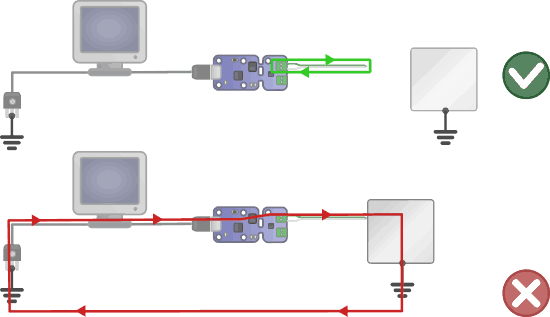Ground Loop is a condition created when two or more parts of a network are grounded at separate points, causing a voltage difference between connected networking components.
What is Ground Loop?
Ground Loop in networking is a condition created when two or more parts of a network are grounded at separate points, causing a voltage difference between connected networking components. These voltage differences typically occur because of nonuniformities in the electrical characteristics of the grounding at different locations.

How it works
For example, consider two computers that are located some distance apart and are connected by coaxial cabling. Each device is also connected to the earth by the ground wire of its AC power cable, but the two devices are plugged into different power outlets. These power outlets are connected to different parts of your building’s electrical distribution system, and these different parts are under different loads (have different currents being drawn from them by different configurations of devices). Thus they provide slightly different voltages. You might also find slight differences in the ground potential at the two locations. These voltage differences can cause currents to be induced through the shielding of the network cabling, and these currents can be large because of the cable’s low resistance. Large pulses of current can occur when other devices on the power circuits are switched on or off abruptly. This situation can be potentially damaging to sensitive networking components and might cause them to reset or lock up.
Ground loops can be prevented by
- Using nonconducting fiber-optic cabling instead of copper cabling, especially for longer cable runs
- Utilizing opto isolators or isolation transformers to break electrical connections between networking components
TIP
Ground loops are especially problematic with serial connections such as RS-232 because cables using this interface have a second signal ground path between the devices. Ground loops can also be a problem with shielded cabling such as shielded twisted-pair (STP) cabling or coaxial cabling.
These loops will occur if the cable’s shielding is grounded by a direct connection to the chassis of the devices, because this provides a second ground path between the devices in addition to that produced by the ground portion of the AC power connection.
The resulting current loops can build up until they are potentially damaging to the connected equipment. To prevent such damage, the shielding in a shielded cable should be grounded only at one end of its connection.
Finally, when grounding a metal rack or cabinet that houses networking equipment, you should ground it using the same AC power cable ground connection that you used for the equipment itself. Note that ground loops are not a significant problem with unshielded twisted-pair (UTP) cabling because the wiring is transformer-isolated in the hub and network interface card (NIC) connections.
